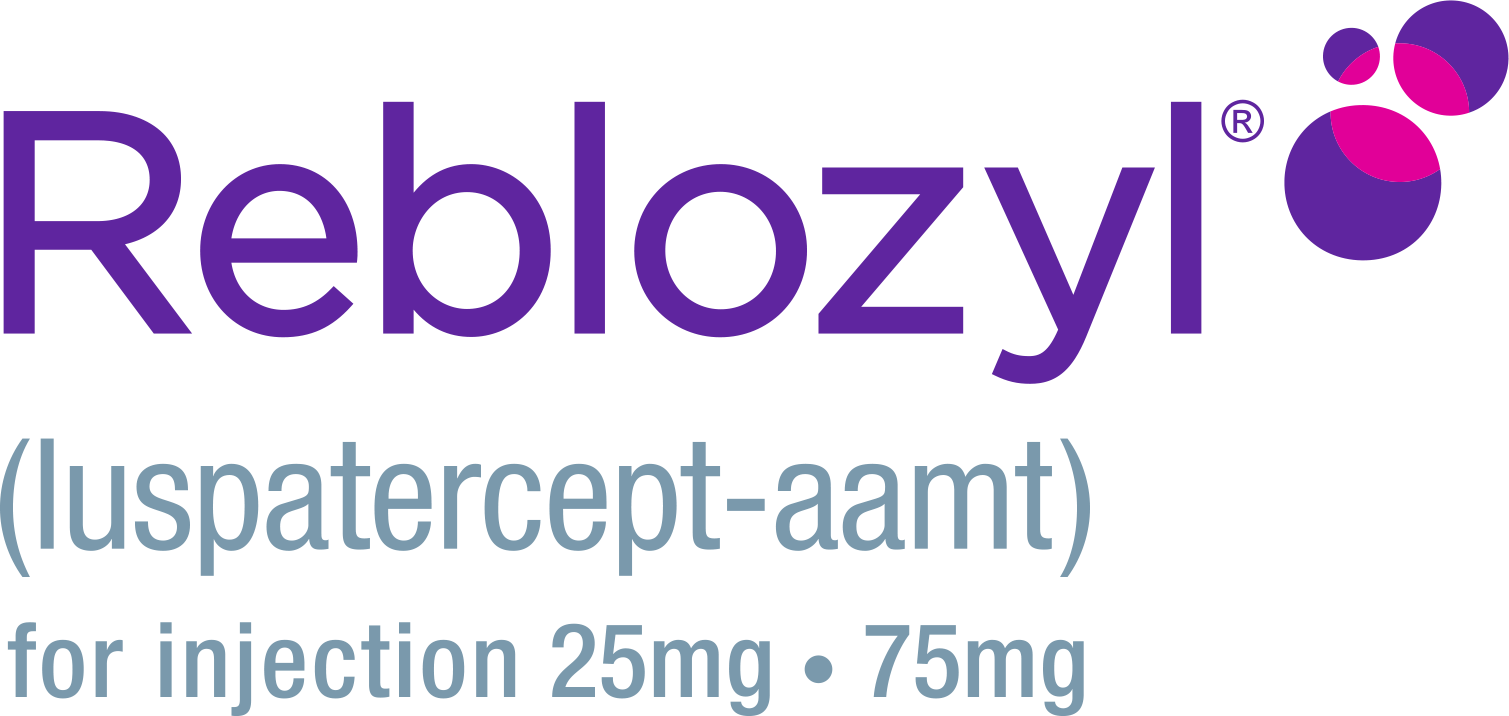SCENARIO |
REBLOZYL
|
|---|---|
| Predose Hgb is ≥11.5 g/dL in the absence of transfusions |
|
| Increase in Hgb >2 g/dL within 3 weeks in the absence of transfusions and: | |
| Current dose to 1.25 mg/kg |
|
| Current dose to 1 mg/kg |
|
| Current dose to 0.8 mg/kg |
|
| Current dose to 0.6 mg/kg |
|
DOSING AND ADMINISTRATION: REBLOZYL DOSING
REBLOZYL has 2 dose levels to optimize response in patients with beta-thalassemia1
Assess and review patients’ Hgb and transfusion record prior to each administration
- If an RBC transfusion occurred prior to dosing, use the pretransfusion Hgb for dose evaluation
- If a patient experiences a dose delay due to Hgb increase, measure Hgb every week2

REBLOZYL dose titration for response1
- Increase REBLOZYL dose with the goal of achieving reduction in transfusion burden, but do not increase if patient is experiencing adverse reactions. Discontinue REBLOZYL after 3 doses at the maximum dose if no transfusion burden reduction or if unacceptable toxicity occurs

Start at 1 mg/kg every 3 weeks for ≥2 doses
Assessment at week 7 for later:
- Continue at 1 mg/kg if patient has reduction in RBC transfusion and has no unacceptable toxicity
- INCREASE* TO 1.25 mg/kg if patient has no reduction in RBC transfusion burden after at least 2 consecutive doses (5 weeks) of 1 mg/kg
Increase to 1.25 mg/kg maximum dose every 3 weeks for 3 doses
Assessment at week 16 or later:
- Continue at 1.25 mg/kg if patient has reduction in RBC transfusion burden and has no unacceptable toxicity
- DISCONTINUE TREATMENT after 5 doses (at least 15 weeks) if patient has no reduction in RBC transfusion burden after 3 consecutive doses (9 weeks) of 1.25 mg/kg
Treat for at least 15 weeks (5 doses) unless unacceptable toxicity occurs at any time
*Do not increase the dose if the patient is experiencing an adverse reaction as described in the Dose Modifications for Adverse Reactions table.
Modifications for predose Hgb levels or rapid Hgb rise1

Dose increase in the event of loss of response1
- A dose increase to 1.25 mg/kg may occur at any time during treatment after patients have received at least 2 consecutive doses of 1 mg/kg
- Do not increase the dose beyond the maximum dose of 1.25 mg/kg

Discontinue treatment if no reduction in transfusion burden is observed1
- Discontinue REBLOZYL if a patient does not experience a decrease in transfusion burden after 3 doses (9 weeks of treatment) at the maximum dose level or if unacceptable toxicity occurs at any time

If a planned administration of REBLOZYL is delayed or missed1
- Administer REBLOZYL as soon as possible and continue dosing as prescribed, with at least 3 weeks between doses
Modifications for predose Hgb levels or rapid Hgb rise1
SCENARIO |
REBLOZYL
|
|---|---|
| Grade 3 or 4 hypersensitivity reactions* |
|
| Other Grade 3 or 4 adverse reactions* |
|
| Extamedullary hematopoietic (EHM) masses causing serious complications |
|
*Grade 1 is mild, Grade 2 is moderate, Grade 3 is severe, and Grade 4 is life-threatening.
†Per dose reductions in table above.
Dosing experience in the BELIEVE trial
54%
(n=120/223)
of patients in the REBLOZYL arm received a maximum dose of 1 mg/kg3
94%
of patients receiving REBLOZYL were exposed for 6 months or longer1
46%
(n=103/223)
of patients in the REBLOZYL arm had their dose increased to 1.25 mg/kg3
72%
of patients receiving REBLOZYL were exposed for greater than 1 year1
147
DAYS
was the median time to first titration in the REBLOZYL arm (min, max: 57, 575 days)2
63.3
WEEKS
was the median duration of treatment with REBLOZYL (similar to placebo group, 62.1 weeks)1
Hgb=hemoglobin; RBC=red blood cell.
REBLOZYL reduces transfusion burden
Learn how to administer REBLOZYL
References: 1. REBLOZYL [US Prescribing Information]. Summit, NJ: Celgene Corporation; 2023. 2. Data on file. Celgene Corporation. Summit, New Jersey. 3. Cappellini MD, Viprakasit V, Taher AT, et al. A phase 3 trial of luspatercept in patients with transfusion-dependent β-thalassemia. N Engl J Med. 2020;382(13):1219-1231.

